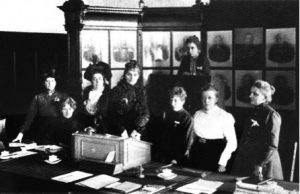Lida Gustava Heymann (1868-1943)
‘‘We have all perceived in the last wretched years of total war that there is a higher good than peace, namely freedom…Where freedom reigns, there also will peace set in”
Lida Gustava Heymann 1868-1943) was a radical feminist and pacifist active in the German middle- and upper-class women’s movement until 1933. She was a co-founder of several national and international women’s organizations, including the German branch of the International Abolitionist Federation and the Union of Progressive Women’s Associations (Verband Fortschrittlicher Frauenvereine) in 1898, the German Union for Women’s Suffrage (Deutscher Verband für Frauenstimmrecht) in 1902, the International Women’s Suffrage Alliance in 1904, and the International Committee of Women for Permanent Peace in 1915, which became the Women’s International League for Peace and Freedom in 1919.
Lida Gustava Heymann was born in March 1867 in the Northern German harbor city Hamburg to a wealthy coffee importer and his wife. Using her inheritance after her father’s death, she become heavily involved in a diverse range of humanitarian and philanthropic projects. She established a day nursery, a soup kitchen, a lunch club for single women, a women’s home, and a society for female clerical workers. In 1898, Heymann joined Minna Cauer and Anita Augspurg in founding the German branch of the International Abolitionist Federation, campaigning for the decriminalization and protection of prostitutes, In the same year, she joined the founders of the Union of Progressive Women’s Associations (Verband Fortschrittlicher Frauenvereine). In 1902 she belonged to the founding group of the German Union for Women’s Suffrage (Deutscher Verband für Frauenstimmrecht, DFV), which was the first women’s suffrage organization in Germany. Until then, only the Social Democratic Party of Germany (SPD) had advocated publicly for universal women’s suffrage. By 1911, the union’s left and right wings could no longer work together due to growing strategic differences over two issues: first, the form of the demanded women’s suffrage¾equal or universal¾, and second, the best strategy¾moderate or militant. After some quarrel, Heymann joined her friends and fellow activists Anita Augspurg and Minna Cauer, who fought for universal suffrage and wanted to pursue a more militant strategy, following the model of the British Women’s Social and Political Union (WSPU) under the leadership of Emmeline Pankhurst (1859-1928). In 1913, they left the DFV for good to set up a more radical association, the German Women’s Suffrage League (Deutscher Frauenstimmrechtsbund).
Much of her women’s rights activism Heymann did alongside Anita Augspurg, whom she met in 1896 at a women’s conference in Berlin. The two remained co-activists and life partners until their death in 1943. Much of their activities were international. In 1904, for example, Heymann and Augspurg began working to establish the International Woman Suffrage Alliance, dedicated to coordinating the national suffrage movements around Europe and the United States. When First World War began in August 1914, both increasingly worked for the cause of achieving international peace. In January 1915, Heymann published an appeal to women across Europe to speak out against the war and work towards securing peace entitled “Women of Europe, When Will Your Call Ring Out?” She also attended the International Congress of Women that took place in The Hague, in the neutral Netherlands, in April 1915. She German delegation was led by her partner Anita Augspurg. The Congress resulted in the founding of the International Committee of Women for Permanent Peace (ICWPP), which changed its name in 1919 to Women’s International League for Peace and Freedom (WILPF). Heymann, like Augspurg, viewed war between nations as a disagreement between male-dominated governments that lacked empathy and understanding. For them, thus, the struggle for equal political right for women was also a struggle for pacifism and international understanding and vice versa. Back from The Hague they tried to build up the German branch of the ICWPP by organizing meetings and a speaker tour. But the German government sought to repress the organization, which was dissolved by government forces in 1916. Heymann and Augspurg had to hide to avoid imprisonment during the war.
After the First World War, Heymann and Augspurg became influential leaders of the Women’s International League for Peace and Freedom. Heymann was vice president of the WILPF from 1919-1924.They also built up the German branch of the WILPF and edited the pacifist-feminist journal Die Frau im Staat (Woman in the State), which they had founded in 1919, until 1932. Because Heymann believed that women had to become active in party politics and parliaments now that women finally got active and passive universal suffrage in Germany, she ran as an SPD candidate for the first elections for the Weimar National Assembly on January 19, 1919, but did not get enough votes.
When the Nazis came into power in January 1933, Heymann and Augspurg left Germany and lived in exile in Zurich on a farm exclusively ran by women. They co-wrote their memoires Erlebtes—Erschautes (Experienced—Seen). The book was not published until 1972, decades after their death in 1943.
Steven Potter, Global Studies, Class of 2018
Sources
Literature and Websites
- “Heymann, Lida Gustava.” In Chambers Biographical Dictionary, by Liam Rodger, and Joan Bakewell. 9th ed. Chambers Harrap, 2011. http://libproxy.lib.unc.edu/login?url=https://search.credoreference.com/content/entry/chambbd/heymann_lida_gustava/0?institutionId=1724.
- “Heymann, Lida (Gustava).” In The Palgrave Macmillan Dictionary of Women’s Biography, ed. Jennifer S. Uglow, Frances Hinton, and Maggy Hendry. 4th ed. Macmillan Publishers Ltd, 2005. http://libproxy.lib.unc.edu/login?url=https://search.credoreference.com/content/entry/macdwb/heymann_lida_gustava/0?institutionId=1724
- “Heymann, Lida Gustava.” In Encyclopedia of Women Social Reformers, ed. Helen Rappaport. ABC-CLIO, 2001. http://libproxy.lib.unc.edu/login?url=https://search.credoreference.com/content/entry/abcwsr/heymann_lida_gustava/0?institutionId=1724
Images



